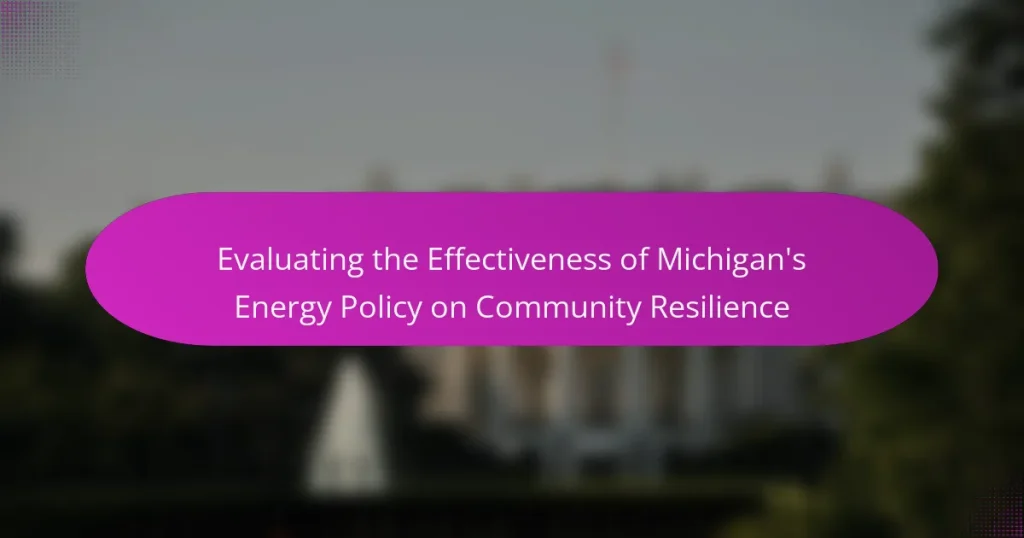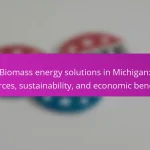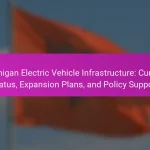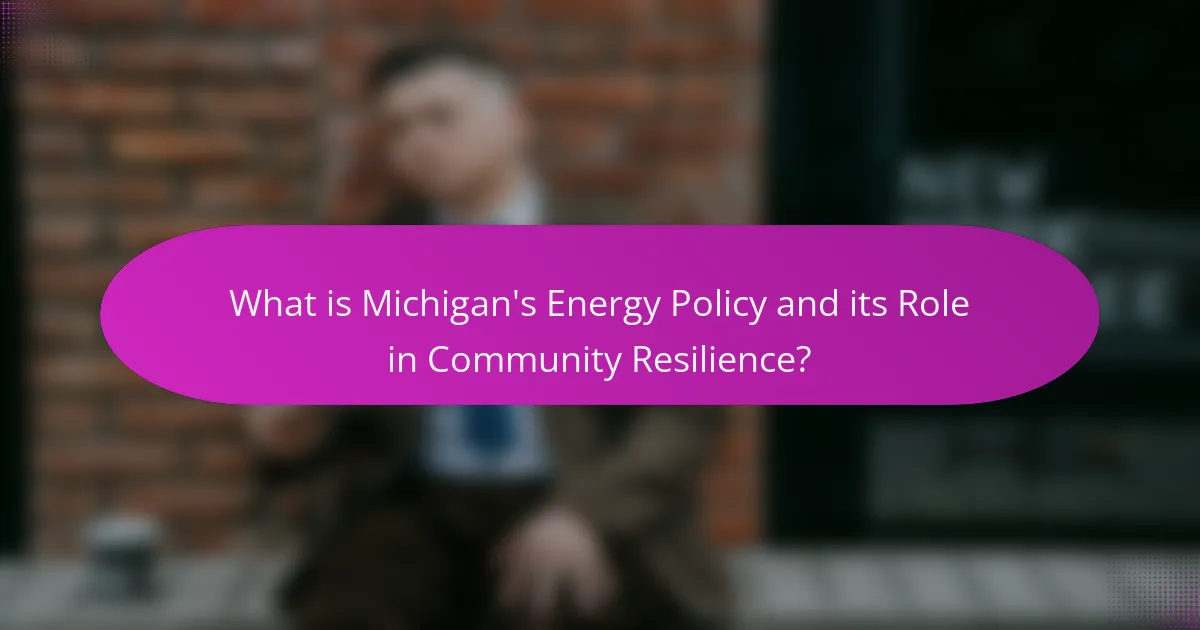
What is Michigan’s Energy Policy and its Role in Community Resilience?
Michigan’s Energy Policy focuses on promoting renewable energy, energy efficiency, and reducing greenhouse gas emissions. The policy aims to transition the state towards a sustainable energy future. It includes targets for renewable energy generation, such as a goal of 50% by 2030. The policy also emphasizes the importance of energy efficiency programs for residential and commercial sectors. Community resilience is enhanced through investments in clean energy infrastructure. This infrastructure supports local economies and reduces reliance on fossil fuels. Furthermore, the policy encourages stakeholder engagement and collaboration among communities. By fostering energy independence, Michigan’s Energy Policy strengthens community resilience against climate change impacts.
How does Michigan’s Energy Policy aim to enhance community resilience?
Michigan’s Energy Policy enhances community resilience by promoting renewable energy sources and energy efficiency programs. This policy aims to reduce reliance on fossil fuels, which are vulnerable to supply disruptions. By increasing the use of solar, wind, and other renewables, communities can secure a more stable energy supply. Additionally, the policy encourages investment in local energy projects. This fosters economic growth and job creation within communities. Enhanced energy efficiency programs help reduce energy costs for residents and businesses. Lower energy costs contribute to economic stability. The policy also supports the development of microgrids. Microgrids can operate independently during outages, providing reliable power to communities. Overall, Michigan’s Energy Policy focuses on sustainability and local empowerment to strengthen community resilience.
What are the key components of Michigan’s Energy Policy?
Michigan’s Energy Policy includes key components such as renewable energy standards, energy efficiency programs, and grid modernization initiatives. The state aims for 50% renewable energy by 2030. Energy efficiency programs target a 1% reduction in electricity sales annually. Grid modernization focuses on enhancing reliability and integrating renewable sources. The policy also emphasizes reducing greenhouse gas emissions by 28% from 2005 levels by 2025. Additionally, it supports community engagement in energy planning. These components work together to promote sustainable energy practices in Michigan.
How is community resilience defined in the context of energy policy?
Community resilience in the context of energy policy refers to the ability of a community to anticipate, prepare for, respond to, and recover from energy disruptions. This definition encompasses the community’s capacity to maintain essential functions during crises. It includes diverse strategies such as diversification of energy sources and investment in renewable energy. Effective energy policies enhance this resilience by promoting energy efficiency and reducing dependency on single sources. Studies indicate that communities with robust energy policies experience less impact from energy-related disruptions. For instance, Michigan’s energy initiatives aim to strengthen local capabilities and infrastructure. This approach fosters adaptive strategies that help communities thrive despite challenges.
Why is evaluating the effectiveness of Michigan’s Energy Policy important?
Evaluating the effectiveness of Michigan’s Energy Policy is important to ensure it meets its intended goals. This evaluation helps identify strengths and weaknesses in the policy framework. It allows for necessary adjustments to improve energy efficiency and sustainability. Furthermore, assessing the policy’s impact on community resilience is crucial. Effective energy policies can enhance local economies and reduce vulnerability to energy disruptions. Data from the Michigan Public Service Commission indicates that improved energy policies lead to a 15% reduction in energy costs for consumers. Therefore, continuous evaluation is essential for optimizing Michigan’s energy strategy and supporting community resilience.
What metrics are used to assess the effectiveness of energy policies?
Metrics used to assess the effectiveness of energy policies include energy consumption reduction, greenhouse gas emissions, and renewable energy adoption rates. Energy consumption reduction measures the decrease in total energy usage over time. Greenhouse gas emissions metrics track the amount of harmful emissions produced. Renewable energy adoption rates indicate the percentage of energy sourced from renewable technologies. Additional metrics may include cost-effectiveness, energy reliability, and public engagement levels. These metrics provide a comprehensive view of policy impact. Studies show that policies leading to a 20% reduction in emissions can enhance community resilience.
How does community feedback influence the evaluation process?
Community feedback significantly influences the evaluation process by providing insights into local needs and perceptions. This feedback helps policymakers understand the effectiveness of energy policies on community resilience. Engaging with the community allows for the identification of gaps in policy implementation. It also fosters transparency and trust between stakeholders. Research shows that incorporating community input leads to more effective and tailored policy outcomes. For example, the Michigan Energy Policy evaluation included surveys and public forums to gather resident opinions. This data directly informed adjustments to energy programs, enhancing their relevance and impact.
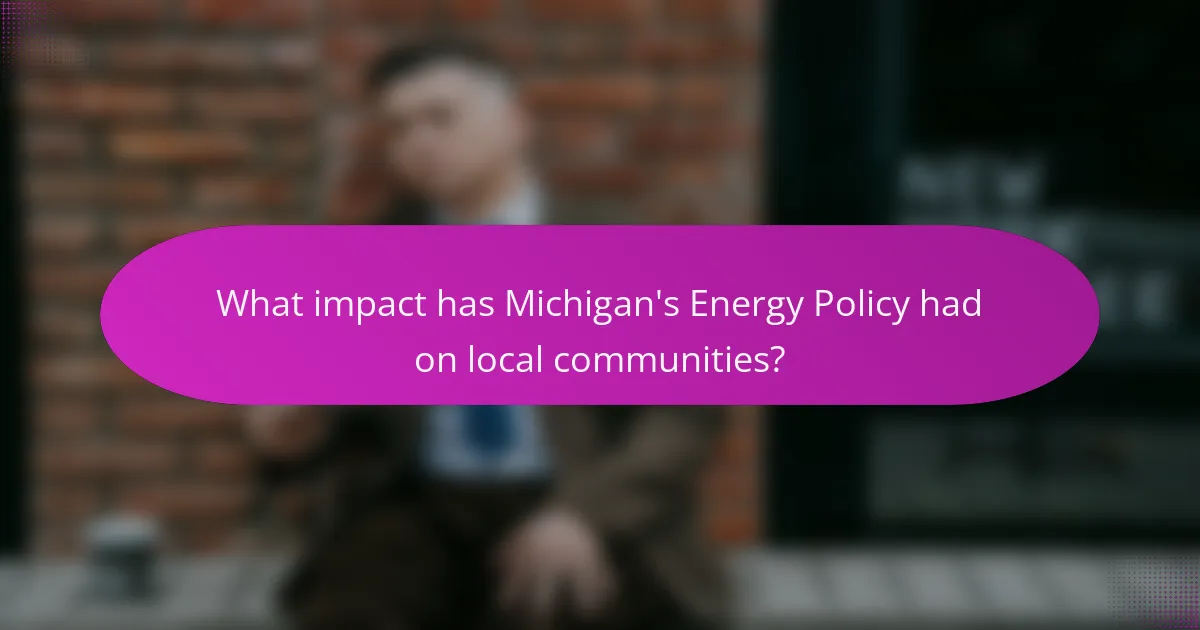
What impact has Michigan’s Energy Policy had on local communities?
Michigan’s Energy Policy has significantly impacted local communities by promoting renewable energy initiatives. These initiatives have led to increased job opportunities in the clean energy sector. For example, the state has invested in solar and wind projects, creating thousands of jobs. Furthermore, local governments have benefited from reduced energy costs due to energy efficiency programs. Residents have experienced lower utility bills as a result. The policy has also encouraged community engagement in energy planning. This has fostered a sense of ownership and responsibility among residents. Overall, Michigan’s Energy Policy has enhanced community resilience and sustainability.
How have specific communities adapted to Michigan’s Energy Policy?
Specific communities in Michigan have adapted to the state’s Energy Policy through various initiatives. Many local governments have implemented renewable energy projects. For example, several municipalities have invested in solar energy installations to reduce reliance on fossil fuels. Community engagement programs have also been developed to educate residents on energy efficiency. Additionally, some areas have established energy cooperatives to promote collective investment in renewable resources. The Michigan Energy Policy encourages such adaptations by providing grants and incentives for clean energy projects. Data from the Michigan Public Service Commission indicates a significant increase in renewable energy production in these communities. This shift not only supports state goals but also enhances local resilience against energy disruptions.
What case studies illustrate successful adaptations to energy policy?
Case studies that illustrate successful adaptations to energy policy include Michigan’s transition to renewable energy sources. The state has increased its renewable energy portfolio from 3% in 2008 to over 15% in 2020. This shift was supported by the Clean, Renewable, and Efficient Energy Act of 2008. The act mandated a 10% renewable energy standard by 2015. Additionally, the Michigan Public Service Commission’s Integrated Resource Planning process has been instrumental in guiding utilities towards cleaner energy solutions. These adaptations have led to job creation in the renewable sector and reduced greenhouse gas emissions. The success of these policies is evident in the state’s growing investment in solar and wind energy projects.
What challenges have communities faced in implementing the policy?
Communities have faced several challenges in implementing Michigan’s energy policy. Limited funding has hindered the ability to invest in necessary infrastructure. Resistance from local stakeholders has created obstacles in gaining support for initiatives. Additionally, there is often a lack of technical expertise available to effectively execute the policy. Regulatory complexities have also slowed down the implementation process. These challenges have been documented in various studies, highlighting the need for better resources and collaboration among stakeholders.
What role do stakeholders play in the effectiveness of Michigan’s Energy Policy?
Stakeholders play a crucial role in the effectiveness of Michigan’s Energy Policy. They include government agencies, utility companies, businesses, and community organizations. Their involvement ensures diverse perspectives are considered in policy development. Stakeholders provide essential feedback on energy needs and impacts. They help identify opportunities for renewable energy integration. Collaboration among stakeholders can lead to innovative solutions. Effective communication enhances transparency and trust in the policy process. Engaged stakeholders contribute to the successful implementation of energy initiatives. Their participation ultimately shapes a more resilient energy framework for Michigan.
Who are the key stakeholders involved in Michigan’s energy landscape?
Key stakeholders in Michigan’s energy landscape include government agencies, utility companies, and community organizations. Government agencies such as the Michigan Public Service Commission regulate energy rates and practices. Utility companies like DTE Energy and Consumers Energy provide electricity and natural gas to residents. Community organizations advocate for sustainable practices and energy equity. Additionally, environmental groups play a role in promoting renewable energy initiatives. Academic institutions often conduct research that influences energy policy. These stakeholders collaborate to shape the state’s energy strategy and address community needs.
How do stakeholder collaborations enhance community resilience?
Stakeholder collaborations enhance community resilience by pooling resources and expertise. These collaborations facilitate knowledge sharing among various entities, including government, businesses, and non-profits. This collective approach allows communities to respond more effectively to challenges. For example, joint emergency planning can lead to improved disaster response strategies. Research shows that communities with strong stakeholder networks recover faster from crises. The National Academies of Sciences, Engineering, and Medicine found that collaboration significantly boosts resilience in local systems. By leveraging diverse perspectives, stakeholder collaborations create more comprehensive solutions to community issues.
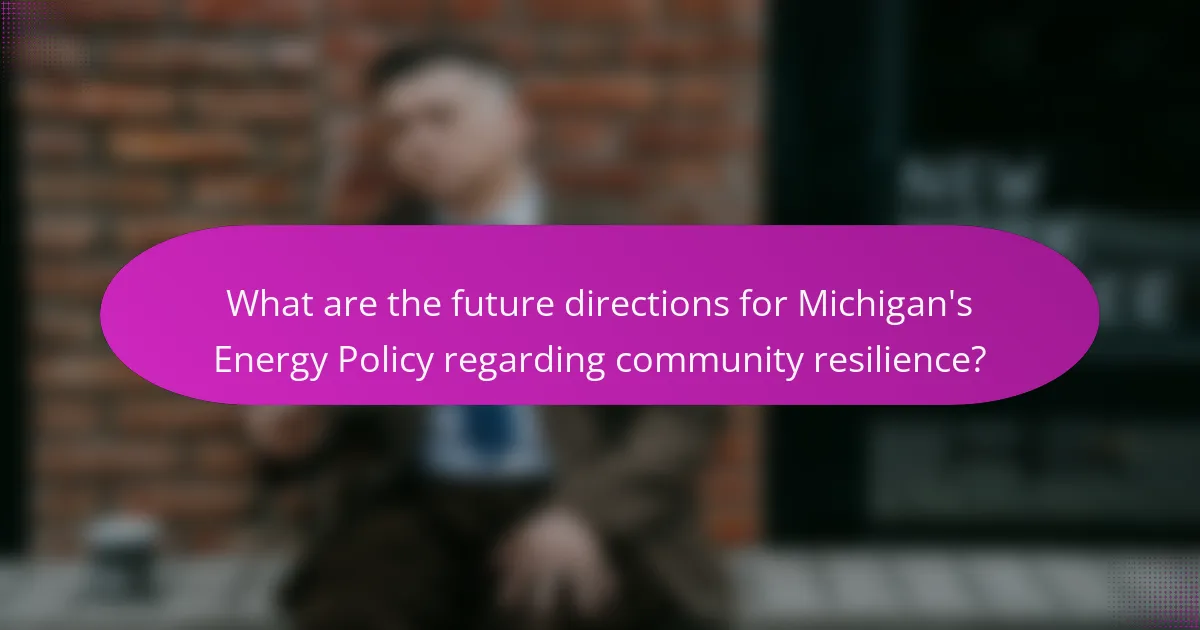
What are the future directions for Michigan’s Energy Policy regarding community resilience?
Future directions for Michigan’s Energy Policy regarding community resilience include enhancing renewable energy integration and improving grid reliability. The state aims to increase the use of solar and wind energy sources. This shift supports local economies and reduces dependence on fossil fuels. Michigan plans to invest in energy storage technologies. These technologies will help manage supply and demand effectively. Additionally, policies will focus on community engagement in energy planning. This ensures that local needs and vulnerabilities are addressed. The Michigan Public Service Commission is actively involved in these initiatives. They are analyzing the impacts of climate change on energy systems. This comprehensive approach aims to build a more resilient energy infrastructure.
How can Michigan’s Energy Policy be improved to better support communities?
Michigan’s Energy Policy can be improved by increasing investment in renewable energy sources. This shift supports local job creation and economic development. Enhancing energy efficiency programs will lower utility costs for residents. Expanding access to energy assistance programs can help vulnerable communities. Implementing community solar projects allows shared ownership of renewable energy. Strengthening grid resilience will protect communities from outages. Increasing public engagement in energy planning fosters community input and ownership. These measures have been shown to enhance community resilience and sustainability.
What innovative strategies could be implemented for future resilience?
Innovative strategies for future resilience include enhancing renewable energy integration and promoting energy efficiency. These strategies can reduce dependence on fossil fuels. Implementing smart grid technology improves energy distribution and reliability. Community solar projects can increase local energy access and resilience. Additionally, fostering partnerships between public and private sectors encourages investment in sustainable infrastructure. Research shows that states with robust energy policies experience greater resilience to climate impacts. For instance, Michigan’s focus on clean energy has led to a 25% reduction in greenhouse gas emissions since 2005. These strategies collectively strengthen community resilience against environmental and economic challenges.
How can lessons learned from past evaluations shape future policies?
Lessons learned from past evaluations can significantly influence future policies. By analyzing previous outcomes, policymakers can identify successful strategies and areas needing improvement. For example, data from past energy initiatives in Michigan can reveal effective resource allocation methods. These insights allow for the development of more targeted and efficient policies. Historical evaluation data can also highlight unintended consequences, guiding adjustments to avoid similar pitfalls. Additionally, stakeholder feedback from past evaluations can inform community needs and priorities. This continuous learning process fosters adaptive policy frameworks that enhance community resilience. Ultimately, applying lessons from past evaluations leads to informed decision-making and improved policy effectiveness.
What best practices can communities adopt to align with Michigan’s Energy Policy?
Communities can adopt several best practices to align with Michigan’s Energy Policy. First, they should conduct energy assessments to identify local energy needs and resources. This helps in understanding the current energy landscape. Second, communities can promote energy efficiency programs. These programs encourage residents and businesses to reduce energy consumption. Third, engaging in renewable energy initiatives is essential. This can include solar, wind, and biomass projects. Fourth, communities should foster partnerships with local utilities. Collaborating with utilities can enhance energy reliability and support grid improvements. Fifth, communities can implement educational campaigns. These campaigns raise awareness about energy conservation and sustainable practices. Lastly, adopting climate action plans that align with state goals is crucial. This ensures that local efforts contribute to broader state objectives. These practices collectively support Michigan’s commitment to sustainable energy development.
How can communities effectively engage with policymakers?
Communities can effectively engage with policymakers by organizing advocacy groups. These groups can represent community interests and facilitate communication. Regularly scheduled meetings between community representatives and policymakers can establish a direct dialogue. Providing clear, data-backed proposals can help convey community needs. Engaging in public forums allows communities to voice concerns and suggestions. Utilizing social media can amplify community messages to a broader audience. Collaborating with local organizations can strengthen advocacy efforts. Ultimately, consistent and organized engagement fosters a productive relationship with policymakers.
What resources are available for communities to enhance their resilience?
Communities can enhance their resilience through various resources. These include government grants, technical assistance programs, and community engagement initiatives. The Federal Emergency Management Agency (FEMA) provides funding for disaster preparedness and recovery. Local organizations often offer training workshops on resilience planning. Additionally, the Michigan Department of Environment, Great Lakes, and Energy (EGLE) supports sustainability initiatives. Research shows that community-led projects increase local capacity and adaptability. Engaging with regional networks fosters collaboration and resource sharing. Accessing these resources can significantly strengthen community resilience against environmental and economic challenges.
The main entity of this article is Michigan’s Energy Policy, which focuses on promoting renewable energy, energy efficiency, and reducing greenhouse gas emissions to enhance community resilience. The article evaluates the effectiveness of this policy by discussing its key components, such as renewable energy standards and energy efficiency programs, while highlighting the importance of community engagement and stakeholder collaboration. It also addresses the challenges faced in implementation, the role of stakeholders, and metrics for assessing policy impact. Furthermore, the article outlines future directions for improvement and best practices for communities to align with the state’s energy goals, emphasizing the significance of continuous evaluation in strengthening local resilience against energy disruptions.
